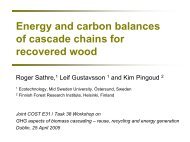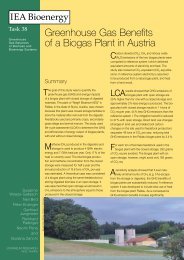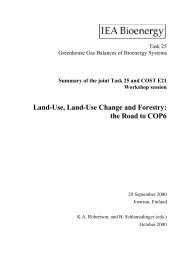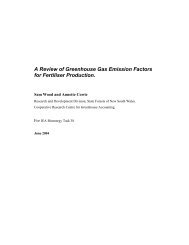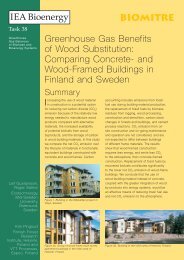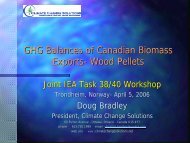Efficient Use of Biomass for Energy in Developing Countries
Efficient Use of Biomass for Energy in Developing Countries
Efficient Use of Biomass for Energy in Developing Countries
- No tags were found...
Create successful ePaper yourself
Turn your PDF publications into a flip-book with our unique Google optimized e-Paper software.
World Bank<strong>Efficient</strong> <strong>Use</strong> <strong>of</strong> <strong>Biomass</strong> <strong>for</strong><strong>Energy</strong> <strong>in</strong> Develop<strong>in</strong>g <strong>Countries</strong>IEA Bioenergy Task 38 ConferenceOstersund, , Sweden September 30, 2003Boris E. Utria, AFTEGRPTES Program Manager /Co-Chair Chair E&P TGThe World Bank1
World Bank1. <strong>Biomass</strong> <strong>Energy</strong> Agenda(AFTEG’s New Vision)3
World Bank“Efficiency”: Economic (Cost/Benefit) Social (Equity) Environmental (Susta<strong>in</strong>ability) Technical (Per<strong>for</strong>mance)4
World BankAFTEG<strong>Biomass</strong> <strong>Energy</strong> Agenda (FY04-07)Vision: Contribute to Poverty Reduction andSusta<strong>in</strong>able Development <strong>in</strong> the Africa Regionthrough the development <strong>of</strong> Comprehensive,Susta<strong>in</strong>able and “<strong>Efficient</strong>” biomass energysector policies, strategies and <strong>in</strong>vestments.NationalBIO-ENERGYStrategySusta<strong>in</strong>ableWoodfuelsprogramBio-EthanolProgramBio-DieselProgramPowerGenerationprogramOtherBio-<strong>Energy</strong>5
World Bank2.Traditional <strong>Biomass</strong> <strong>Energy</strong>& Rural Development• Senegal PROGEDE Example6
World BankAFTEGTraditional <strong>Biomass</strong> Fuels• TBF currently 70%+ <strong>of</strong> total energyconsumed <strong>in</strong> Africa• 80% AFR households currentlydepend on biomass fuels• 50% AFR household will depend onTBF <strong>for</strong> next 2-3 decadesRuralUrban7
Senegal PROGEDE“Susta<strong>in</strong>able & Participatory <strong>Energy</strong> Management Project”Eco+Soc+Env+Tech EfficiencyMulti-sectorial / Assets-based Rural DevelopmentParticipatory NRM & CDD ApproachEnvironmental Susta<strong>in</strong>ability / Climate Change8
Senegal PROGEDE: NR Assets DevelopmentWorld BankSusta<strong>in</strong>able Forest/NRM ManagementSusta<strong>in</strong>able Fuelwood Production/salesSusta<strong>in</strong>able Forest/NRM ManagementImproved Carbonization MethodsSusta<strong>in</strong>able Charcoal Production/Sale99
World BankSenegal PROGEDE: Productive AssetsCrop DiversificationAnimal HusbandryProcess WaterHoney ProductionValue Added Products10
World BankSenegal PROGEDE: Social AssetsPotable WaterGenderCapacity Development & MobilizationChildrenFamily Health & Nutrition EducationChildren/YouthEnvironmental & <strong>Energy</strong> Education11
Senegal PROGEDE: Support AssetsImproved Stoves /Inter-fuel SubstitutionImproved Stoves /Inter-fuel SubstitutionImproved Stoves /Inter-fuel SubstitutionImproved Stoves /Inter-fuel Substitution12
World Bank3. Modern <strong>Biomass</strong> <strong>Energy</strong>& Susta<strong>in</strong>able Development• The Brazilian ProAlcool Program• AFR: Millennium Gelfuel Initiative• B-MESDV Vehicle• “Susta<strong>in</strong>able Development Eng<strong>in</strong>e” Concept• Employment Generation Impacts13
World BankAFTEGModern <strong>Biomass</strong> <strong>Energy</strong>Ethanol, Bio-Diesel,other bio-fuels, Power, Etc.• Large employment generation potential PR• Local production import substitution• Ecosystem rehabilitation• Cleaner fuels CO2 abatement• Cleaner Hh fuels reduced “<strong>in</strong>-door” pollution• Potential exports balance <strong>of</strong> payments• Private Sector participation14
BRASIL: PROALCOOL Ma<strong>in</strong> Achievements & Impacts 12 million m 3 ethanolethanol (20X 1975);Oil displacement: 200,000 barrels/day; 2.5 million neat ethanol cars <strong>in</strong> operation15.5 million cars us<strong>in</strong>g 22% anhydrousethanol-gasol<strong>in</strong>e blend; ; > 1/3 <strong>of</strong> gasol<strong>in</strong>edisplaced; $48 billion FOREX expendituresavoided <strong>in</strong> 1975-02, with an <strong>in</strong>vestment <strong>of</strong>$5 billion (2001 $) <strong>in</strong> local currency.15
BRASIL: PROALCOOL Ma<strong>in</strong> achievements & impacts(Cont.) 320 million metric tons <strong>of</strong> sugarcane produced<strong>in</strong> 2002 (4 times more than <strong>in</strong> 1975); 20 millionton sugar (3X 1975); > 300 ethanol distileries (200 annexed); 25,000gas stations sell<strong>in</strong>g hydrous ethanol today;700,000 permanent jobs 700,000created <strong>in</strong> production cha<strong>in</strong> @ US$10-20K/job(4x lower than avg.)16
BRASIL: PROALCOOL Ma<strong>in</strong> achievements & impacts(Cont.) Demonstration: massive biomassprogram established <strong>in</strong> a short term; Sugarcane/sugar/ethanol technologydevelopment demonstrated by productivity<strong>in</strong>creases and cost reduction; Development <strong>of</strong> market based Ethanolprice system; “Lessons Learned” <strong>for</strong> replication.17
BRASIL: PROALCOOL Environmental Impacts(Cont.) Lead displacement due to octane enhancementproperties <strong>of</strong> ethanol: lead concentrations <strong>in</strong>São Paulo dropped 93% from 1978 to 1991 NO x , CO and Sulfur emissions from ethanol fuels arereduced while HC (hydrocarbons) and aldehydeemissions are <strong>in</strong>creased. However ethanol HCs andaldehydes are less toxic than gasol<strong>in</strong>e’s. The environmental impacts from ethanol production,particulally the stillage disposal, have been resolved CO 2 emissions from ethanol vehicles are absorbedback by sugarcane grow<strong>in</strong>g <strong>in</strong> a closed cycle, mak<strong>in</strong>gethanol fuel eligible <strong>for</strong> CDM / Kyoto Protocol18
AFR: Millennium Gelfuel InitiativeRPTESWorld Bank2-liter Re-cycled bottle2-liter Re-cycled bottleDevelopmentMarketplace 2000Orig<strong>in</strong>al bottleOrig<strong>in</strong>al bottle“RPTES” MG Stove“DM 2001 Stove”“DM 2001 Stove”MILLENNIUM GELFUEL“DM “DM 2002 2002 Stove” (2Stove” (2(2-Plate)(2-Plate)W<strong>in</strong>d Shield(Optional)W<strong>in</strong>d Shield(Optional)“RPTES” Burner“RPTES” Burner@RPTES 2002“RPTES” Burners“RPTES” Burners“JIKO” MG Stove@RPTES 2002@RPTES 2002@RPTES 2002THE WORLD BANKWorld Bank + Private Sector + DM19
World BankMGI: Status Report (Sept 03)@RPTES 2002MILLENNIUM GELFUEL@RPTES 2002• Technical R&D: Fuel + Stovescompleted• Private Sector: 3 Commercial plants<strong>in</strong> operation (Zimbabwe, South Africa,Malawi)• IFC/GEF Medium Size Projects:Malawi and Ethiopia (FY03/04)• EUBIA/Ch<strong>in</strong>a Project: GuandongProv<strong>in</strong>ce (80tn/Yr)• 20+ countries <strong>in</strong>terested on MGI (Africa,Asia & LAC)20
World BankBio-diesel Multi-<strong>Energy</strong> Service Delivery Vehicle“Gett<strong>in</strong>g There - GT”B-MESDV• 4x4 Transport: Cargo& Passenger (low Speed)• Mechanization• Water Pump<strong>in</strong>g• Crop Gr<strong>in</strong>d<strong>in</strong>g• Basic DC Power• Battery Charg<strong>in</strong>gGreenTrac A/S (Norway)PROGEDE (Senegal)World Bank / DM200321
World BankBio-diesel Multi-<strong>Energy</strong> Service Delivery VehicleB-MESDVDevelopmentMarketplace 20032-Axel Steer<strong>in</strong>gGreenTrac A/S (Norway)“Gett<strong>in</strong>g There - GT”Vehicle Concept30 0 30 02-Axel Independent Pivot<strong>in</strong>g22
World Bank4. <strong>Biomass</strong> <strong>Energy</strong> & PovertyAlleviation “Model”• “Susta<strong>in</strong>able Rural Development Eng<strong>in</strong>e”Concept• Employment Generation Impacts23
Ethanol/Millennium Gelfuel: A Susta<strong>in</strong>able Eng<strong>in</strong>e <strong>for</strong> Rural Trans<strong>for</strong>mationInvestments• Private Sector• Public SectorProduction <strong>of</strong> NewAgricultural Crops AgriculturalEmployment &Incomes Econ. Activity& DiversificationOpen<strong>in</strong>g <strong>of</strong> NewProduction Zones EcosystemRehabilitationPoverty Alleviation Access: ConsumerGoods, Soc. Services,Education, etc.= Increase/Improvement; = Decrease/Reduction.24
Ethanol/Millennium Gelfuel: A Susta<strong>in</strong>able Eng<strong>in</strong>e <strong>for</strong> Rural Trans<strong>for</strong>mationInvestments• Private Sector (70%)• Public Sector (15%)• “Climate Change”Mechanisms (15% 15%)ETHANOLProduction <strong>of</strong> NewAgricultural Crops Agro-<strong>in</strong>dustrialEmployment Economic ActivityPoverty Alleviation AgriculturalEmployment &Incomes Econ. Activity& DiversificationOpen<strong>in</strong>g <strong>of</strong> NewProduction Zones EcosystemRehabilitationEthanolBy-ProductsPoverty Alleviation Access: ConsumerGoods, Soc. Services,Education, etc.= Increase/Improvement; = Decrease/Reduction.25
Ethanol/Millennium Gelfuel: A Susta<strong>in</strong>able Eng<strong>in</strong>e <strong>for</strong> Rural Trans<strong>for</strong>mationInvestments• Private Sector (70%)• Public Sector (15%)• “Climate Change”Mechanisms (15% 15%)MillenniumGelfuelETHANOL <strong>in</strong>dustrialEmploymentProduction <strong>of</strong> NewAgricultural Crops AgriculturalEmployment &Incomes Econ. Activity& DiversificationOpen<strong>in</strong>g <strong>of</strong> NewProduction Zones EcosystemRehabilitationPoverty Alleviation Access: ConsumerGoods, Soc. Services,Education, etc. Agro-<strong>in</strong>dustrialEmployment Economic ActivityPoverty AlleviationEthanolBy-ProductsGasol<strong>in</strong>e Blend<strong>in</strong>g /SubstitutionPowerGenerationEthanolExportsFertilizersBrewersYeastRural PowerGenerationOther= Increase/Improvement; = Decrease/Reduction.26
Ethanol/Millennium Gelfuel: A Susta<strong>in</strong>able Eng<strong>in</strong>e <strong>for</strong> Rural Trans<strong>for</strong>mationInvestments• Private Sector (70%)• Public Sector (15%)• “Climate Change”Mechanisms (15% 15%)ETHANOLMillenniumGelfuel <strong>in</strong>dustrialEmployment WoodfuelsSubstitution KeroseneSubstitution Stable Hhold<strong>Energy</strong> MarketsCO2 Emissions &In-Door Pollution Bal.PaymentProduction <strong>of</strong> NewAgricultural Crops Agro-<strong>in</strong>dustrialEmployment Economic ActivityGasol<strong>in</strong>e Blend<strong>in</strong>g /SubstitutionPowerGeneration TransportCO2 Emissions Bal.Payment Power Gen. CapacityPoverty AlleviationEthanolExports FOREX Bal. Payment AgriculturalEmployment &Incomes Econ. Activity& DiversificationFertilizers Ag.Production Bal. PaymentOpen<strong>in</strong>g <strong>of</strong> NewProduction Zones EcosystemRehabilitationPoverty Alleviation Access: ConsumerGoods, Soc. Services,Education, etc.EthanolBy-ProductsBrewersYeastRural PowerGenerationOther Human Consumption Animal Feed Rural Electricity Access= Increase/Improvement; = Decrease/Reduction.27
Inversión• Sector Privado (70%)• Sector Publico (15%)• Mecanismos “CambioClimatico”(15% 15%)Visión n Estratégica“ECODER”ETANOLSubstitucionGasol<strong>in</strong>a/Diesel Empleo Industrial Balanza de Pagos Emisiones CO2Transportes Estabilidad MercadosEnergeticos Substitucion Lena& Coc<strong>in</strong>olProducción/Reconversiónde Nuevos CultivosAgrícolas Empleo Agro-<strong>in</strong>dustrial Actividad EconomicaMillenniumGelfuelGeneracionElectricidad Emisiones CO2 &Polucion Residencial Balanza de Pagos Cap.GeneracionReduccion PobrezaExportacionEtanol Captacion Divisas Balanza de Pagos Empleos Agricolas eIngresos Rurales Actividad economica && DiversificacionFertilizantes Produc. Agricola Balanza de PagosApertura de NuevasZonas de productionLevadura Consumo Humano Rehabilitacion/consevacionSuelos & AmbientalReduccion de la Pobreza Acceso: bienes de consumo,Servicios Sociales,Educacion, etc.Sub-productosDe EtanolGeneracionElectricidadOtros Raciones Animales Acceso Electrificacion= Aumento/Mejoría; = Dism<strong>in</strong>ución/Reducción.28
RPTESWorld BankMILLENNIUM GELFUELA Renewable and Low-Cost Cook<strong>in</strong>g Fuel <strong>for</strong> AfricaTABLE 2: Land Requirements, Rural Employment and Millennium Gelfuel Production From 25% and 50% Increase <strong>in</strong> Agricultural Crops <strong>in</strong> Africa (1)25% ProductionIncrease over SUGAR CROPS STARCH CROPS ALL CROPSYear '2000 SUGAR CANE SWEET SORGHUM CASSAVA MAIZE SWEET POTATOES TOTALSCrop Levels (2) (3) (4) (2) (3) (4) (2) (3) (4) (2) (3) (4) (2) (3) (4) (2) (3) (4)Ha Jobs Gelfuel Ha Jobs Gelfuel Ha Jobs Gelfuel Ha Jobs Gelfuel Ha Jobs Gelfuel Ha Jobs GelfuelREGION (10 6 ) (10 6 ) (10 6 Lt) (10 6 ) (10 6 ) (10 6 Lt) (10 6 ) (10 6 ) (10 6 Lt) (10 6 ) (10 6 ) (10 6 Lt) (10 6 ) (10 6 ) (10 6 Lt) (10 6 ) (10 6 ) (10 6 Lt)Central Africa 0.1 0.0 93.3 0.4 0.2 122.3 0.6 0.2 1,257.7 0.7 0.2 385.6 0.0 0.0 39.8 1.7 0.7 1,898.5Eastern Africa 0.1 0.1 437.1 0.8 0.4 301.7 0.8 0.4 1,250.7 2.7 0.9 1,989.6 0.3 0.1 275.5 4.8 1.8 4,254.6Southern Africa 0.1 0.0 583.4 0.1 0.0 54.1 0.0 0.0 0.0 0.9 0.3 1,611.1 0.0 0.0 2.5 1.1 0.4 2,251.1Western Africa 0.0 0.0 89.3 3.0 1.3 1,116.0 1.2 0.5 2,610.9 1.8 0.6 1,331.0 0.1 0.1 134.4 6.2 2.5 5,281.6Total -> 0.3 0.1 1,203.1 4.3 1.8 1,594.1 2.6 1.1 5,119.3 6.1 2.1 5,317.2 0.5 0.2 452.2 13.8 5.4 13,685.950% IncreaseCentral Africa 0.1 0.1 186.5 0.8 0.3 244.5 1.1 0.5 2,515.4 1.4 0.5 771.2 0.1 0.0 62.6 3.4 1.4 3,780.1Eastern Africa 0.2 0.1 874.2 1.7 0.7 603.3 1.6 0.7 2,501.4 5.4 1.9 3,979.2 0.7 0.3 551.0 9.6 3.7 8,509.2Southern Africa 0.2 0.1 1,166.8 0.1 0.1 108.3 0.0 0.0 0.0 1.9 0.7 3,222.2 0.0 0.0 5.1 2.2 0.8 4,502.3Western Africa 0.0 0.0 178.7 6.1 2.5 2,232.0 2.4 1.0 5,221.8 3.6 1.3 2,662.0 0.3 0.1 268.7 12.3 5.0 10,563.2Total -> 0.5 0.3 2,406.1 8.7 3.6 3,188.1 5.1 2.3 10,238.6 12.2 4.3 10,634.5 1.0 0.4 887.4 27.5 10.8 27,354.8Source: Phillips, T., "Agro-Economic Assessment <strong>of</strong> the Potential to Produce Fermentation Ethanol Alcohol In Africa", RPTES Program, 2002.Notes: (1) Projections based on 25 and 50 percent <strong>of</strong> 2001 and production <strong>of</strong> the specific crop. It is assumed that yields rema<strong>in</strong> constant and that labour<strong>in</strong>puts will <strong>in</strong>crease <strong>in</strong> proportion to production <strong>in</strong>creases. Required land expansion was constra<strong>in</strong>ed by availability <strong>of</strong> suitable land. Sources:(a) <strong>for</strong> Production data: FAO, Agricultural Production, FAOSTAT (http://apps.fao.org/); (b) <strong>for</strong> Suitability data: IIASA and FAO. (2000); and,(c) <strong>for</strong> Global Agro-Ecological Zones http://www.fao.org/ag/AGL/agll/gaez/<strong>in</strong>dex.htm.(2) Land requirements <strong>of</strong> projection scenarios presented <strong>in</strong> million Hectares (Ha).(3) Employment Generation presented <strong>in</strong> millions and only reflect new jobs <strong>in</strong> the agricultural production phase. Actual number calculated on thebasis <strong>of</strong> total number <strong>of</strong> day/person labour <strong>in</strong>put divided by 250 workdays/year. Agro-<strong>in</strong>dustrial employment <strong>in</strong> ethanol distillation and gelfuelproduction is estimated to be <strong>of</strong> the order <strong>of</strong> 100,000 new permanent jobs not <strong>in</strong>cluded.(4) Millennium Gelfuel production calculated on the basis <strong>of</strong> 1.2:1 volume ratio with respect to ethanol alcohol production.World Bank29
RPTESWorld BankMILLENNIUM GELFUELA Renewable and Low-Cost Cook<strong>in</strong>g Fuel <strong>for</strong> AfricaTABLE 2: Land Requirements, Rural Employment and Millennium Gelfuel Production From 25% and 50% Increase <strong>in</strong> Agricultural Crops <strong>in</strong> Africa (1)25% ProductionIncrease over SUGAR CROPS STARCH CROPS ALL CROPSYear '2000 SUGAR CANE SWEET SORGHUM CASSAVA MAIZE SWEET POTATOES TOTALSCrop Levels (2) (3) (4) (2) (3) (4) (2) (3) (4) (2) (3) (4) (2) (3) (4) (2) (3) (4)Ha Jobs Gelfuel Ha Jobs Gelfuel Ha Jobs Gelfuel Ha Jobs Gelfuel Ha Jobs Gelfuel Ha Jobs GelfuelREGION (10 6 ) (10 6 ) (10 6 Lt) (10 6 ) (10 6 ) (10 6 Lt) (10 6 ) (10 6 ) (10 6 Lt) (10 6 ) (10 6 ) (10 6 Lt) (10 6 ) (10 6 ) (10 6 Lt) (10 6 ) (10 6 ) (10 6 Lt)Central Africa 0.1 0.0 93.3 0.4 0.2 122.3 0.6 0.2 1,257.7 0.7 0.2 385.6 0.0 0.0 39.8 1.7 0.7 1,898.5Eastern Africa 0.1 0.1 437.1 0.8 0.4 301.7 0.8 0.4 1,250.7 2.7 0.9 1,989.6 0.3 0.1 275.5 4.8 1.8 4,254.6Southern Africa 0.1 0.0 583.4 0.1 0.0 54.1 0.0 0.0 0.0 0.9 0.3 1,611.1 0.0 0.0 2.5 1.1 0.4 2,251.1Western Africa 0.0 0.0 89.3 3.0 1.3 1,116.0 1.2 0.5 2,610.9 1.8 0.6 1,331.0 0.1 0.1 134.4 6.2 2.5 5,281.6Total -> 0.3 0.1 1,203.1 4.3 1.8 1,594.1 2.6 1.1 5,119.3 6.1 2.1 5,317.2 0.5 0.2 452.2 13.8 5.4 13,685.950% IncreaseCentral Africa 0.1 0.1 186.5 0.8 0.3 244.5 1.1 0.5 2,515.4 1.4 0.5 771.2 0.1 0.0 62.6 3.4 1.4 3,780.1Eastern Africa 0.2 0.1 874.2 1.7 0.7 603.3 1.6 0.7 2,501.4 5.4 1.9 3,979.2 0.7 0.3 551.0 9.6 3.7 8,509.2Southern Africa 0.2 0.1 1,166.8 0.1 0.1 108.3 0.0 0.0 0.0 1.9 0.7 3,222.2 0.0 0.0 5.1 2.2 0.8 4,502.3Western Africa 0.0 0.0 178.7 6.1 2.5 2,232.0 2.4 1.0 5,221.8 3.6 1.3 2,662.0 0.3 0.1 268.7 12.3 5.0 10,563.2Total -> 0.5 0.3 2,406.1 8.7 3.6 3,188.1 5.1 2.3 10,238.6 12.2 4.3 10,634.5 1.0 0.4 887.4 27.5 10.8 27,354.8Source: Phillips, T., "Agro-Economic Assessment <strong>of</strong> the Potential to Produce Fermentation Ethanol Alcohol In Africa", RPTES Program, 2002.Notes: (1) Projections based on 25 and 50 percent <strong>of</strong> 2001 and production <strong>of</strong> the specific crop. It is assumed that yields rema<strong>in</strong> constant and that labour<strong>in</strong>puts will <strong>in</strong>crease <strong>in</strong> proportion to production <strong>in</strong>creases. Required land expansion was constra<strong>in</strong>ed by availability <strong>of</strong> suitable land. Sources:(a) <strong>for</strong> Production data: FAO, Agricultural Production, FAOSTAT (http://apps.fao.org/); (b) <strong>for</strong> Suitability data: IIASA and FAO. (2000); and,(c) <strong>for</strong> Global Agro-Ecological Zones http://www.fao.org/ag/AGL/agll/gaez/<strong>in</strong>dex.htm.(2) Land requirements <strong>of</strong> projection scenarios presented <strong>in</strong> million Hectares (Ha).(3) Employment Generation presented <strong>in</strong> millions and only reflect new jobs <strong>in</strong> the agricultural production phase. Actual number calculated on thebasis <strong>of</strong> total number <strong>of</strong> day/person labour <strong>in</strong>put divided by 250 workdays/year. Agro-<strong>in</strong>dustrial employment <strong>in</strong> ethanol distillation and gelfuelproduction is estimated to be <strong>of</strong> the order <strong>of</strong> 100,000 new permanent jobs not <strong>in</strong>cluded.(4) Millennium Gelfuel production calculated on the basis <strong>of</strong> 1.2:1 volume ratio with respect to ethanol alcohol production.World Bank30
COLOMBIA:Scenario: 180,000 Empleos/500,000 Ha. *Land Requirements, Ethanol Production, Employment andInvestment EnvelopeGENERACION DE EMPLEOS DIRECTOSAlcohol Nivel Capacacitacion INVERSIONBiomasa Etanol Bajo Medio Alto Total REQUERIDATon/Yr Lt/Yr 60% 10% 30% 100% # Empleos Baja AltaCULTIVOS Hectareas (Millones) (Millones) (Millones Persona/Dia/ha.) Permanentes (Millones US $)Cana de Azucar 100,000 5 350 6 1 3 10 37,037 91 156Sorgo Sacar<strong>in</strong>o 150,000 14 745 11 2 5 18 66,667 1,236 2,120Maiz 150,000 1 333 7 1 3 11 40,833 86 148Yuca 100,000 1 216 6 1 3 9 34,815 56 96Total 500,000 21 1,644 29 5 15 48 179,352 1,470 2,519(*) Target proposed by national government with<strong>in</strong> the “Plan Colombia” Context is <strong>of</strong>380,000 ha. <strong>for</strong> the 2002-2006 period.31
COLOMBIA:Scenario: 180,000 Empleos/500,000 Ha. *Land Requirements, Ethanol Production, Employment andInvestment EnvelopeGENERACION DE EMPLEOS DIRECTOSAlcohol Nivel Capacacitacion INVERSIONBiomasa Etanol Bajo Medio Alto Total REQUERIDATon/Yr Lt/Yr 60% 10% 30% 100% # Empleos Baja AltaCULTIVOS Hectareas (Millones) (Millones) (Millones Persona/Dia/ha.) Permanentes (Millones US $)Cana de Azucar 100,000 5 350 6 1 3 10 37,037 91 156Sorgo Sacar<strong>in</strong>o 150,000 14 745 11 2 5 18 66,667 1,236 2,120Maiz 150,000 1 333 7 1 3 11 40,833 86 148Yuca 100,000 1 216 6 1 3 9 34,815 56 96Total 500,000 21 1,644 29 5 15 48 179,352 1,470 2,519(*) Target proposed by national government with<strong>in</strong> the “Plan Colombia” Context is <strong>of</strong>380,000 ha. <strong>for</strong> the 2002-2006 period.32
World BankAFTEG<strong>Biomass</strong> <strong>Energy</strong>: Summary <strong>of</strong> Impacts• Economic Benefits• Rural employment <strong>in</strong> TBF, MBE and NRM• Significant <strong>in</strong>come generation Agriculture & Agro-<strong>in</strong>dustry• Mobilization & enhancement <strong>of</strong> exist<strong>in</strong>g “Rural Assets”• Social Benefits (Rural & Urban)• POVERTY REDUCTION opportunities• Households welfare & Health• Gender development and equity• Environmental ImpactsEnvironmental Impacts• Forests/natural resource conservation (NR Assets)• Eco-susta<strong>in</strong>ability / Ecosystem rehabilitation• Reduced Co2 emissions, air & “<strong>in</strong>-door” pollution• Climate Change mitigation33
World Bank5. <strong>Biomass</strong> <strong>Energy</strong> Inventory &Poverty Impact AssessmentMethodology34
World BankAFTEG/BEWP (FY04-07)<strong>Biomass</strong> <strong>Energy</strong> Inventory & AssessmentINVENTORY & ENERGY OUTPUTPOTENTIAL ASSESSMENTWoody<strong>Biomass</strong>Ag. Crops<strong>Energy</strong>Output<strong>Energy</strong>Output• <strong>Biomass</strong> <strong>Energy</strong>Inventory: establishpotential bio-energyscenarios (carriersand output levels).Agro-Residues<strong>Energy</strong>Output35
World BankAFTEG/BEWP (FY04-07)<strong>Biomass</strong> <strong>Energy</strong> Inventory & AssessmentINVENTORY & ENERGY OUTPUTPOTENTIAL ASSESSMENTWoody<strong>Biomass</strong>Ag. CropsAgro-Residues<strong>Energy</strong>Output<strong>Energy</strong>Output<strong>Energy</strong>OutputCLIMATE CHANGEASSESSMENT(Evaluation <strong>of</strong> CDM $Mobilization )• <strong>Biomass</strong> <strong>Energy</strong>Inventory: establishpotential bio-energyscenarios (carriers andoutput levels).• Climate ChangeAssessment: establishcompliance <strong>of</strong> potentialbio-energy scenarioswith Agenda 21 andUNCCC and estimatepossible mobilization <strong>of</strong>CC fund<strong>in</strong>g.36
World BankAFTEG/BEWP (FY04-07)<strong>Biomass</strong> <strong>Energy</strong> Inventory & AssessmentINVENTORY & ENERGY OUTPUTPOTENTIAL ASSESSMENTWoody<strong>Biomass</strong>Ag. CropsAgro-Residues<strong>Energy</strong>Output<strong>Energy</strong>Output<strong>Energy</strong>OutputCLIMATE CHANGEASSESSMENT(Evaluation <strong>of</strong> CDM $Mobilization )• <strong>Biomass</strong> <strong>Energy</strong>Inventory: establishpotential bio-energyscenarios (carriers andoutput levels).• Climate ChangeAssessment: establishcompliance <strong>of</strong> potential bioenergyscenarios withAgenda 21 and UNCCCand estimate possiblemobilization <strong>of</strong> CC fund<strong>in</strong>g.POVERTY ASSESSMENT (MDG/PRSP MATRIX)EmploymentNewEconomicActivityGDP GrowthSOCIAL DEV.MDG #1MDG #2MDG #3MDG #4MDG #5MDG #6MDG #7PRSPMATRIXCASPRSC+ SI + SA• Poverty Assessment:estimate impacts <strong>of</strong>potential bio-energyscenarios with respect toMDGs and WB povertyalleviation objectives, andelaborate PRSP energysector coefficients toassist <strong>in</strong> def<strong>in</strong>ition <strong>of</strong>CASes and operational<strong>in</strong>struments.37
World BankRequest to o the ……IEA Bioenergy Task 38 & Co.: Comprehensive <strong>Biomass</strong> <strong>Energy</strong>Environmental/CC relevant data CDM Qualification Standards <strong>for</strong><strong>Biomass</strong> <strong>Energy</strong>/fuels “Translated” Assessment Toolkits Technical Assistance Support38
World Bank<strong>Biomass</strong> <strong>Energy</strong>Poverty Reduction<strong>Energy</strong> AccessRural/Agricultural DevelopmentEnvironmental Susta<strong>in</strong>ability39
Thanks For Your Attention.The End.40




